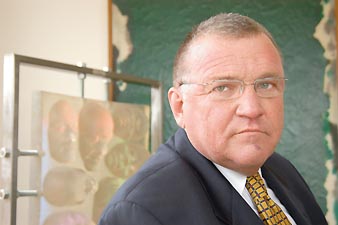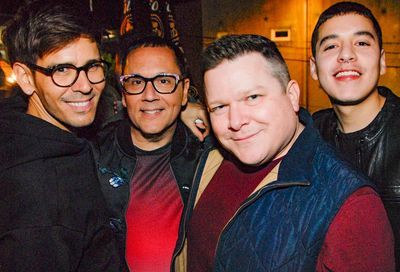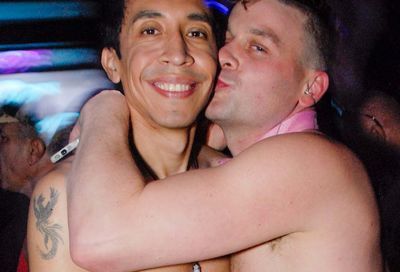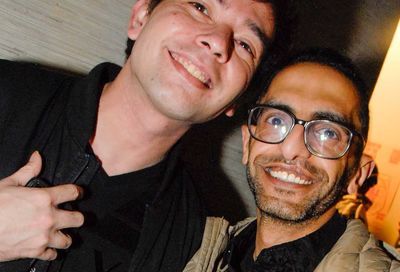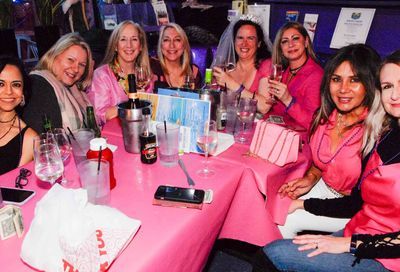Domestic Disturbance
Before DOMA, there was another debate over marriage – within the gay and lesbian community
by Chris Geidner
May 4, 2011
Part One of a series marking the 15th anniversary of the passage of the Defense of Marriage Act
Talking with Andrew Sullivan about marriage is a bit like asking a blue whale what he ate for dinner. Once he starts, there’s really no end.

(Photo Illustration by Todd Franson. Original cake photo by James Steidl/iStockphoto)
”At any particular point, we weren’t clear what would happen next,” he says, sitting at a coffee shop on a warm, early spring afternoon. ”It was way more contingent. You tend to look back on these things with a sense of inevitability, and I hate it when people say, ‘Well, they’re just on the wrong side of history.’
”Bullshit. History is what people make of it. There’s nothing inevitable.”
That much is clear from a simple glance at a map of the United States, where, more than 20 years after Sullivan started pushing this cause, only five states – Massachusetts, Connecticut, Iowa, Vermont and New Hampshire – and the District of Columbia allow same-sex couples to obtain marriage licenses.
Fifteen years ago, though, it was another state — Hawaii, whose Supreme Court ruling and ongoing case in which three same-sex couples were seeking marriage licenses — that captured the nation’s attention.
In addition to the nation’s attention, says Rep. Barney Frank (D-Mass.), the issue caught the eye of the lagging presidential campaign of then-Senate Minority Leader Bob Dole (R-Kan.), which ”saw this as a classic wedge issue” and prompted Rep. Bob Barr (R-Ga.) to introduce the Defense of Marriage Act to stop same-sex couples and their lawyers from, as Frank says, ”bringing same-sex marriage to every state.”
Elizabeth Birch, then the executive director of the Human Rights Campaign, describes 1996 as a very uncertain time. ”This is what we understood,” she says, ”Hawaii was bubbling along – even the legal organizations were very nervous about Hawaii in the beginning. At the time, it was one of the most potent, difficult issues. Even Democrats had tremendous issues with it privately – even our best friends.”
Including President Bill Clinton, whose political advisors pushed him to sign the bill, according to Richard Socarides, Clinton’s liaison to the gay and lesbian community at the time.
”Fifteen years later, I think we can be fairly candid about why that happened,” Socarides says. “And the only reason it happened is because the people who believed that vetoing the bill would have jeopardized the president’s election won the political argument. That’s the only reason the bill got signed.”
But for Freedom to Marry President Evan Wolfson, who was a lawyer at Lambda Legal at the time and was co-counsel on the Hawaii case, DOMA is a complicated story.
”If I had had to pick which would you rather have, a win in Hawaii or subsequent state or blocking DOMA, I would have chosen the win. Because, without the wins first, we weren’t going anywhere,” he says. ”If necessary, we would overturn DOMA on the strength of the wins, and that’s exactly what’s now happening.”
The story of DOMA – from the religious right to the gay and lesbian groups and from Congress to Clinton – is important to understanding what’s now happening in Congress and from the Obama administration. That story itself, however, is incomplete without looking at the ways in which gay, lesbian and bisexual people and their allies sought recognition of their relationships – and debated about the best way of doing so – from as early as the years immediately following the 1969 uprising at the Stonewall Inn.
”What They Propose Is Not a Marriage”
IT WAS ROUGHLY 40 years ago that what Wolfson refers to as the ”first wave of marriage cases” began. Coming ”within two years of Stonewall,” he says, ”there were three major cases making their way up courts.”
Along with a New York trial court case involving a transgender woman who the court found ”was not a female at the time of the marriage ceremony,” the challenges – in Minnesota, Kentucky and Washington state – were met with hostility or simple disbelief from the courts.
In the Minnesota case, Baker v. Nelson, the state’s high court upheld the trial court’s ruling that the U.S. Constitution was not violated by the fact that Richard John Baker and James Michael McConnell had been denied a marriage license. The blunt language of the court’s opinion, issued in October 1971, showed the uphill battle ahead for those same-sex couples seeking the right to marry.
Minnesota Supreme Court Justice C. Donald Peterson noted the religious roots of marriage, writing for the court, ”The institution of marriage as a union of man and woman, uniquely involving the procreation and rearing of children within a family, is as old as the book of Genesis.”
The court also dismissed comparisons to the then-recent decision striking down anti-miscegenation laws in Loving v. Virginia, with Justice Peterson holding, ”[I]n commonsense and in a constitutional sense, there is a clear distinction between a marital restriction based merely upon race and one based upon the fundamental difference in sex.”
A year later, the United States Supreme Court appeared to agree, dismissing the appeal summarily because there was no ”substantial federal question” in the case. In other words, it was not even plausible to think that the Equal Protection or Due Process clauses of the Constitution’s 14th Amendment could be applicable to gay or lesbian people or their relationships.
In November 1973, the Kentucky Court of Appeals was more direct when responding to Marjorie Jones and her partner’s claim that they were wrongly denied a marriage license from the county court clerk of Jefferson County: ”[M]arriage has always been considered as the union of a man and a woman and we have been presented with no authority to the contrary. … A license to enter into a status or a relationship which the parties are incapable of achieving is a nullity….
“[T]he relationship proposed by the appellants,” the court concluded, “does not authorize the issuance of a marriage license because what they propose is not a marriage.”
As Sullivan says today, ”We were basically told it was … an absurd, illegitimate request: marriage. Definitionally: not gay.”
A year later, it was no different when a Washington appellate court upheld the denial of John Singer and Paul Barwick’s attempt to marry. In Washington state, the court had to address the fact that its relevant statutes did not explicitly limit marriage to one man and one woman.
”[T]he definition of marriage as the legal union of one man and one woman who are otherwise qualified to enter into the relationship,” the court held, was ”so obvious as not to require recitation.”
”Going After the Central Problem”
LESS THAN 10 years later, in May 1983, as AIDS began its emergence as the defining political – and personal – battle of the gay community, Evan Wolfson was graduating from Harvard Law School.
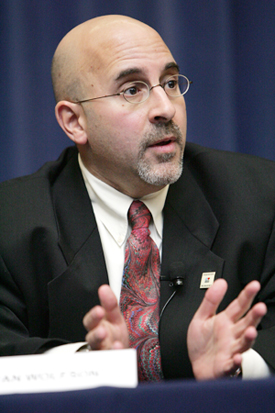
Evan Wolfson
”I wrote my third-year paper in law school – my version of a dissertation – on why gay people should have the freedom to marry,” says Wolfson. ”[I] always believed that this was important for us to fight for, a, in its own right and, b, as an engine for moving everything along.”
But when Wolfson began practicing law in the area – first as a pro bono attorney with Lambda Legal and then as one of its then-small staff of attorneys – his efforts to turn his thesis into a project he hoped would one day become reality hit a snag not often discussed these days: the conflicting views of other gay, lesbian and bisexual people.
”It was the subject of big divisions within the movement, within the legal groups and within Lambda,” he says, noting there were two distinct approaches from opponents. ”There was the ideological opposition, and the strategic or tactical or timing opposition.”
That ideological opposition, in some ways, was led by Paula Ettelbrick, the first staff attorney at Lambda Legal and the organization’s legal director – hence, one of Wolfson’s bosses – from 1988 through early 1993.
Ettelbrick, author of ”Since When Is Marriage the Path to Liberation?,” the leading feminist argument against Wolfson’s path, says she has changed – and not changed – her views on marriage over the years.
”[T]his issue has been on [my] radar at least since the early to mid ’80s,” Ettelbrick says. ”I think the way to situate the perspective here is to look historically at what was guiding our thinking at different points of time. For me, it was feminism, it was progressive politics – which was very much endemic in the gay community and certainly in the lesbian feminist community – about going after the central problems. Not just looking for fixes, but going after the central problem.”
That ”central problem,” she says, was – and is – that marriage is the only vehicle for relationship recognition.
”I feel very firmly that we need to continue the broader recognition, that we should insist on marriage and non-marriage – in a sense – family relationships.”
It wasn’t just Ettelbrick and Wolfson intellectually sparring. Wolfson talks about the disputes over marriage at the legal roundtable – attorneys at gay and lesbian rights legal groups, academics and other lawyers who would meet regularly.
”That was the biggest dividing line, the biggest source of arguing amongst a group that might quibble or haggle over a particular legal idea but basically agreed over a whole range of things,” says Wolfson. ”The one thing that people would argue about more than any other was marriage.”
”Nobody was going to challenge that we needed to get rid of sodomy laws,” Ettelbrick explains. “No one was going to challenge that we needed antidiscrimination laws to deal with everything from HIV to sexual orientation.”
But marriage ”was hotly debated.”
She adds, ”I think it was a really important part of our movement that’s seldom been fully addressed, to tell you the truth.”
That debate also took hold because Lambda Legal Executive Director Tom Stoddard shared Wolfson’s view. Stoddard’s opposing viewpoint article – ”Why Gay People Should Seek the Right to Marry” – was regularly paired with Ettelbrick’s article to exemplify the debate in the years that followed.
Of the importance of the articles, Ettelbrick notes, ”We both represented, first of all, different sides of the coin in this argument, and also, we were both at Lambda Legal Defense, which was a central organization to deciding about the future of litigation of these cases. So the movement question was not just, ‘How do we deal with these competing views?’ but also, ‘How does an organization like Lambda deal with the two leaders of the organization having such differing perspectives?”’
”Civil Unions? After All That?”
AS THE LATE 1980s hit and AIDS was decimating the gay community, Stoddard and Wolfson found an unlikely ally in Andrew Sullivan. With a striking cover story – ”Here Comes the Groom” – in The New Republic on Aug. 28, 1989, Sullivan began making a different case for marriage.
The article’s subhead was ”A (Conservative) Case for Gay Marriage” and Sullivan made the argument that recognition of gay relationships was important – both in principle and practicality.
Describing the roots of gay politics since Stonewall and the transition that came about because of AIDS, Sullivan wrote, ”A need to rebel has quietly ceded to a desire to belong. … Certainly since AIDS, to be gay and to be responsible has become a necessity.”
Sullivan says that one of the lessons of the time is the story of ”how the gay rights movement grew out of the AIDS crisis as a very serious national movement.”
He recalls the men who would come up to him when he talked about his marriage work, telling him, ”’This isn’t some sort of moral issue about bathhouses or whatever, or what we should do as gay men. It is that I need to be able to see my husband in hospital and I need not to be stripped of all my belongings immediately thereafter by his angry relatives.”’
Of the movement as a serious force, Sullivan says, ”It hadn’t been that, really, beforehand. It had been an urban and regional and sort of defensive gathering of groups. It had not been a national, coherent strategy.”
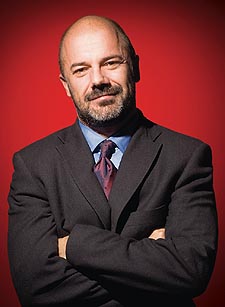
Andrew Sullivan
(Photo by Todd Franson)
Sullivan advocated focusing on marriage and military service because those issues not only highlighted discrimination by the government, but expanded the narrative of gay lives.
”Those stories, those causes, would re-describe gay people in the minds of straight people,” he says. ”The images they would put out there of gay people – soldiers, people living in families, which was the truth of who we were – was an important counterbalance to the only thing they previously had seen, which was gay rights parades, which, however wonderful they are, are not fully representative of who gay people are.”
For a conservative like Sullivan, it changed the terms of the debate, as well.
”Straight people understood marriage more than they understood defense of sexual freedom,” he adds. ”And yet we had been trapped into this … ghetto of defending sexual freedom. And then asking people not to be mean to us. Which, I thought, was the basic gay rights movement until the early ’90s.”
That ”defense of sexual freedom” was provided during the debate by people like Michael Warner, who countered Sullivan’s book, Virtually Normal, with his own book published in 2000, The Trouble With Normal.
”At a time when the largest gay organizations are pushing for same-sex marriage,” Warner writes in his preface, “I argue that this strategy is a mistake and represents a widespread loss of vision in the movement.”
Even people like Ettelbrick were seeking more, not less, governmental recognition of relationships, which alienated the position articulated by Warner and others – mainly in academia – who agreed with him.
But as Ettelbrick points out, ”Even within that pro-marriage part, you have people who differ.”
Including Sullivan and Wolfson, who disagreed over the political course, albeit privately.
”We didn’t really air it, but it was an interesting debate,” says Sullivan. ”Evan kind of pitched his proposal as, ‘We can get this very quickly nationally by one state’ – which I always thought was a reckless overreach.
”Publicly we were one, but, personally, I didn’t really believe it should be automatically imposed on everybody in America. I thought we needed time to let this evolve in the public consciousness, and that was not going to happen overnight and that we should take every opportunity to educate.”
To that end, Sullivan says of his view of marriage and the military, ”Anything that got either of those two issues debated would change the narrative and legitimize it.”
For others in the gay, lesbian and bisexual community, however, this raised the other main concern with the ”marriage project.”
As Elizabeth Birch, HRC’s executive director from 1995 through 2004, says today, ”I think back in those days, the judgment was, ‘We don’t even have employment protections’ – and we still don’t. Eventually, there were two schools: You could really leapfrog forward by going for what was seen as a very precious right – the right to marriage – or you could do it kind of incrementally.”
Ettelbrick looks at the ”foundation” that she says was being built in court as another reason for advocating the incremental approach.
”We needed to use domestic partnership and other kinds of vehicles to begin to address the legitimacy of our relationships, period,” she says, which was happening through decisions on gay custody, second-parent adoption and local-government recognition of domestic partnerships. ”There was a very strong argument that we needed that foundation because that was helping the American public kind of acclimate to our relationships.”
AIDS, Ettelbrick says, had made clear the need for that acclimation.
”Legislatures around the country were introducing legislation to quarantine gay men,” she says. ”We were the scourge of the earth at that point, and our relationships were deemed not only immoral and criminal, but unhealthy. So, in that context, to even raise the specter of marriage just seemed ridiculous, from a strategic perspective – was the argument.”
For Sullivan, the reality of AIDS and the fear it engendered created his passion to fight for marriage.
”I really don’t think you can overstate the weird confluence of those two events – a gay rights movement that emerges in the ’60s and ’70s in its most potent force, and it gets slapped down, really, by catastrophe. And the moment that’s interesting is the moment when, instead of capitulating, it actually emboldens them more. We organized in different ways, and we fought back.”
Sullivan then references ”the memory of people’s lost spouses,” and tells the story of a man whose partner had just died of complications from AIDS.
The man was singing a show tune in the hospital, where he had been ”cut off completely, won’t be allowed to go to the funeral, has been kicked out of his home, [yet] he’s been singing that same song since the morning. Because, it’s their song, and it’s his last way of staying in touch.”
”It still gets me today,” Sullivan says, crying. Am I going to let that happen without somebody, somewhere, insisting [on marriage]? Fuck this. Civil unions? After all that? Fuck you.
”You have to multiply that experience so many times in the memory of that generation to understand why we were completely committed to this – even when everybody told us it was nuts.”
But for Ettelbrick, the reality of the matter is that domestic partnerships or civil unions can make the difference someone like Sullivan is seeking.
”I just don’t buy the argument that domestic partnership is second-class citizenship,” she says. ”I’ve never bought that argument.”
Looking at today’s legal landscape, she says, ”When you are in the context in which you need those health benefits or you need that recognition, it is a very important thing that New Jersey allows recognition of your family and of your relationship. Whether it’s called marriage or not, you get all of the benefits. Now, it might be that culturally we still want the term marriage, but from a legal perspective, from a needs-based perspective, it’s … damaging for people to argue the second-class citizenship.”
Birch makes clear that she – and HRC – believed such an incremental approach had merit – in large part because the specter of same-sex marriage ”was the most potent piece in their arsenal against us.”
Of HRC’s approach at the time, though, Sullivan is characteristically blunt.
”They were like, ‘No, we want to get ENDA. … We know that has higher polling, we can do it.’ And my position was, ‘Screw ENDA. First, this is a more fundamental issue about the government discriminating against us as opposed to our fellow citizens, and, secondly, if we win this, the argument that we make on this will so change the debate that ENDA will become easy.’ And their view was totally understandable — I’m not saying it wasn’t.”
But, as Sullivan says he told people at the time, ”It’s coming anyway. The courts are going to have to make these decisions.”
”This Isn’t Just About Hawaii”
SULLIVAN, IN A way, was right – although the first legal same-sex marriages didn’t start in America until about 15 years after his New Republic cover story.
The way the ”second wave” started, though, was not quite how Wolfson had planned.
”I was asked by couples in Hawaii who knew of me … if I would consider taking this case,” he says. ”And I was interested in doing that, but I was told by Lambda, no, that we were not going to do it. And all the other legal groups turned them down as well.”
Wolfson calls that decision ”one of the best things to happen” to the movement.
“It led the couples back to a local Hawaii attorney, a non-gay guy named Dan Foley, who did take the case and brought to it just this extraordinary savvy and credibility on the ground in Hawaii that we would have never had.”
Birch concurs. ”Ultimately, what was great about it – the way anything happens in American history – is that ordinary citizens go to get their rights. It wasn’t orchestrated. It wasn’t impact litigation. It really was people just wanting a marriage license in Hawaii.”
And 20 years ago, on May 1, 1991, they did. Ninia Baehr, Genora Dancel, Tammy Rodrigues, Antoinette Pregil, Pat Lagon and Joseph Melilio – three same-sex couples – filed a complaint in a Hawaii trial court seeking the same marriage license that had been sought and denied previously during the first wave of marriage cases.
Lambda allowed him to give behind-the-scenes support, Wolfson says, and he and Foley became close over the course of the case, which was dismissed by the trial court – just as had happened 20 years earlier to Richard John Baker and James Michael McConnell.
This time, however, the Supreme Court saw the matter in a different light when it heard the case on appeal.
On May 5, 1993, the Hawaii Supreme Court recognized that it was possible for same-sex couples to show that denying them marriage licenses violated their state constitutional rights.
Hawaii Supreme Court Justice Steven H. Levinson wrote the opinion for the court, detailing – case by case – how the decisions in that ”first wave” were an ”exercise in tortured and conclusory sophistry.”
Instead, the Hawaii Supreme Court held that Hawaii’s marriage restriction was a sex-based classification and, thus, subject under Hawaii’s Constitution to strict scrutiny. This meant that the marriage prohibition for same-sex couples ”is presumed to be unconstitutional” unless the state could prove at the trial court that ”the statute’s sex-based classification is justified by compelling state interests and … the statute is narrowly drawn to avoid unnecessary abridgments of the applicant couples’ constitutional rights.”
Wolfson told his Lambda Legal colleagues, ”Whatever you thought before, wherever you were with all these other divisions, the world had just turned. … This was a whole new era; it would never be the same again.”
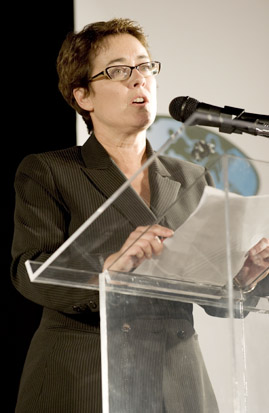
Paula Ettelbrick
As Ettelbrick says, this changed not only the external world, but also the ideological debate within the gay and lesbian world.
”We were immediately launched into a battle that made it very odd for people like myself because, obviously, in no way was I ever going to defend the attacks on the Hawaii decision as they started playing out in legislatures around the country.”
As the case returned to the trial court so that it could apply the Hawaii Supreme Court’s new standard, Lambda allowed Wolfson to join the case as co-counsel and launched the National Freedom to Marry Coalition to push political organizing efforts.
The need for public education quickly became apparent.
Elizabeth Birch says that, at the time, ”What we heard happened is that the [Republican National Committee] started doing really intensive polling and research, and they were trying to find an issue – a really potent wedge issue. … What popped was gay marriage and the numbers were astoundingly negative. They were, ‘My God, look at this!”’
Barney Frank says Republicans seized on the way in which ”the rhetoric on our side played into it” with the declarations that same-sex marriage would follow nationwide after Hawaii.
”Everywhere in the country wasn’t ready for it,” he says. “So [Republicans] then could argue, ‘See, we gotta stop it, this isn’t just about Hawaii. They’re bringing same-sex marriage to every state.”’
Birch sums up the strategy: ”They figured out, ‘Man, if we can drive a wedge between gay voters and gay money and the Democratic Party, wouldn’t that be great? And, at the same time, we could use this issue to paint the Democratic Party as silly and frivolous in that, you know, this is what they’re going to focus on.”’
As Ettelbrick says, ”At that point, who knew how it was going to turn out? It looked like the whole world was going up in flames over our relationships.”
”I Heard Rumblings”
THE WEDGE WAS the Defense of Marriage Act.
”I heard rumblings that they were considering it, playing with it, I think as early as ’95, certainly in ’96,” Wolfson says. ”It wasn’t just another anti-gay effort happening in Congress, which had happened before, but it was one that was being done in the full spotlight of a presidential campaign and with enough people on our side that there was a debate. It wasn’t just a routine anti-gay thing.”
It wasn’t. The brief bill – introduced by Republican Rep. Bob Barr of Georgia – only contained three provisions, and one of those was the title.
The first substantive provision stated that ”[n]o State, territory, or possession of the United States, or Indian tribe, shall be required to give effect to any public act, record, or judicial proceeding of any other State, territory, possession, or tribe respecting a relationship between persons of the same sex that is treated as a marriage under the laws of such other State, territory, possession, or tribe, or a right or claim arising from such relationship.”
The second provision – the federal definition of marriage – stated, ”In determining the meaning of any Act of Congress, or of any ruling, regulation, or interpretation of the various administrative bureaus and agencies of the United States, the word ‘marriage’ means only a legal union between one man and one woman as husband and wife, and the word ‘spouse’ refers only to a person of the opposite sex who is a husband or a wife.”
With seven co-sponsors – Reps. Ed Bryant (R-Tenn.), Bill Emerson (R-Mo.), Steve Largent (R-Okla.), Sue Myrick (R-N.C.), James Sensenbrenner Jr. (R-Wisc.), Ike Skelton (D-Mo.) and Harold Volkmer (R-Mo.) – Barr introduced the bill in Congress just 137 days before it would be signed into law by Democratic President Bill Clinton.
The date was 15 years ago this week, May 7, 1996.
This was the first part of a series marking the 15th anniversary of the passage of the Defense of Marriage Act. The aim of the series is to present an in-depth examination of the circumstances, consideration and passage of the 1996 federal marriage law.

Part 1: Domestic Disturbance
Before DOMA, there was another debate over marriage – within the gay and lesbian community
Part 2: Marriage Wars
In 1996, DOMA went from being introduced to being passed by the House – and given the OK of the Clinton administration – in less than 10 weeks
Part 3: Double Defeat
In 1996, ENDA was hoped to help ease the pain of DOMA, but instead fell by one vote in a Senate focused on a ”thinly disguised example of intolerance”
Part 4: Becoming Law
On Sept. 21, 1996, President Clinton signed DOMA into law – a turning point for the marriage debate that left a mark of discrimination still on the books
Nashville Settles HIV Discrimination Lawsuit
The Metro Nashville government agreed to adopt policies allowing people with HIV to serve as police officers.
By John Riley on April 5, 2024 @JRileyMW
The Metropolitan Government of Nashville and Davidson County settled a lawsuit brought by Lambda Legal alleging that the Metropolitan Nashville Police Department's hiring policies unfairly discriminated against people with HIV.
The lawsuit claimed that the plaintiff, a 45-year-old decorated civil servant going by the pseudonym John Doe, had applied to work for the police department in 2020, and was initially offered a job.
However, the department later rescinded that offer after learning, during the Civil Service Medical Officer's exam process, that Doe is living with HIV.
David Mixner: Politically Speaking – The Metro Weekly Interview
To say that David Mixner has opinions on just about everything is an understatement. We get to know the legendary gay politico.
By Randy Shulman on March 12, 2024 @RandyShulman
Editor's Note: This in-depth interview with David Mixner, who passed away on Monday, March 11, 2024, at the age of 77, originally appeared in the issue of July 29, 2004. Photography by Todd Franson.
"You want a soundbite?"
David Mixner grins.
"I'll give you a soundbite. I'm a man who's devoted forty years of his life -- sometimes at great validation and sometimes at great pain -- to the struggle for freedom and human rights.
"You know, when I was a child growing up," he continues, "we didn't have television, but we got Life magazine. And it opened the outside world to us. As a kid I said, 'I want to live the history of my times. I want to witness it.' And then I got to a second level where I said, 'God, if I could just meet and shake the hands of the people making the history of my times, I'd be happy.' And then I said to myself, 'If I could just be a tiny footnote in the history of my times.'
Court Blocks West Virginia Trans Athlete Ban
A federal appeals court ruled that West Virginia's transgender athlete ban is unconstitutional and violates laws against sex discrimination.
By John Riley on April 16, 2024 @JRileyMW
On Tuesday, April 16, a federal appeals court voted to block a West Virginia law banning transgender student-athletes from competing on teams that align with their gender identity.
The 4th U.S. Circuit Court of Appeals found that the ban, which was signed into law by Republican Gov. Jim Justice in April 2021, violates the rights of transgender students under Title IX, the federal statute that prohibits sex-based discrimination.
The law was challenged by a slew of civil rights and LGBTQ organizations on behalf of B.P.J., a 13-year-old transgender girl and middle school track and cross-country athlete who wishes to compete as a girl.
Support Metro Weekly’s Journalism
These are challenging times for news organizations. And yet it’s crucial we stay active and provide vital resources and information to both our local readers and the world. So won’t you please take a moment and consider supporting Metro Weekly with a membership? For as little as $5 a month, you can help ensure Metro Weekly magazine and MetroWeekly.com remain free, viable resources as we provide the best, most diverse, culturally-resonant LGBTQ coverage in both the D.C. region and around the world. Memberships come with exclusive perks and discounts, your own personal digital delivery of each week’s magazine (and an archive), access to our Member's Lounge when it launches this fall, and exclusive members-only items like Metro Weekly Membership Mugs and Tote Bags! Check out all our membership levels here and please join us today!
The Magazine
-
Most Popular
 Grindr's New Feature "Roam" Connects Users Around the Globe
Grindr's New Feature "Roam" Connects Users Around the Globe  HRC's Kelley Robinson Makes the Time 100 List
HRC's Kelley Robinson Makes the Time 100 List  DC Black Pride 2024: Everything You Need to Know
DC Black Pride 2024: Everything You Need to Know  Turning 'The Outsiders' Into a Musical Was a Mistake (Review)
Turning 'The Outsiders' Into a Musical Was a Mistake (Review)  Conservative Ad Makes Case for Transgender Rights
Conservative Ad Makes Case for Transgender Rights  Mississippi Man Accused of Slaughtering Ex-Boyfriend
Mississippi Man Accused of Slaughtering Ex-Boyfriend  Star Trek Discovery's Wilson Cruz Keeps Making Television History
Star Trek Discovery's Wilson Cruz Keeps Making Television History  Kansas Governor Vetoes Trans Health Care Ban
Kansas Governor Vetoes Trans Health Care Ban  Melania Trump to Host Log Cabin Republicans at Mar-a-Lago
Melania Trump to Host Log Cabin Republicans at Mar-a-Lago  A Christian Gym Teacher Used Grindr to Rob Gay Men
A Christian Gym Teacher Used Grindr to Rob Gay Men
 HRC's Kelley Robinson Makes the Time 100 List
HRC's Kelley Robinson Makes the Time 100 List  Grindr's New Feature "Roam" Connects Users Around the Globe
Grindr's New Feature "Roam" Connects Users Around the Globe  Kansas Governor Vetoes Trans Health Care Ban
Kansas Governor Vetoes Trans Health Care Ban  Court Blocks West Virginia Trans Athlete Ban
Court Blocks West Virginia Trans Athlete Ban  DC Black Pride 2024: Everything You Need to Know
DC Black Pride 2024: Everything You Need to Know  Conservative Ad Makes Case for Transgender Rights
Conservative Ad Makes Case for Transgender Rights  How Vending Machines Can Save Lives in Substance Abuse Crisis
How Vending Machines Can Save Lives in Substance Abuse Crisis  Star Trek Discovery's Wilson Cruz Keeps Making Television History
Star Trek Discovery's Wilson Cruz Keeps Making Television History  Christopher D. Betts Cooks Up a Tasty "Hot Wing King"
Christopher D. Betts Cooks Up a Tasty "Hot Wing King"  Turning 'The Outsiders' Into a Musical Was a Mistake (Review)
Turning 'The Outsiders' Into a Musical Was a Mistake (Review)
Scene
Metro Weekly
Washington's LGBTQ Magazine
P.O. Box 11559
Washington, DC 20008 (202) 638-6830
About Us pageFollow Us:
· Facebook
· Twitter
· Flipboard
· YouTube
· Instagram
· RSS News | RSS SceneArchives
- "We use cookies and other data collection technologies to provide the best experience for our customers. You may request that your data not be shared with third parties here: "Do Not Sell My Data
Copyright ©2024 Jansi LLC.





